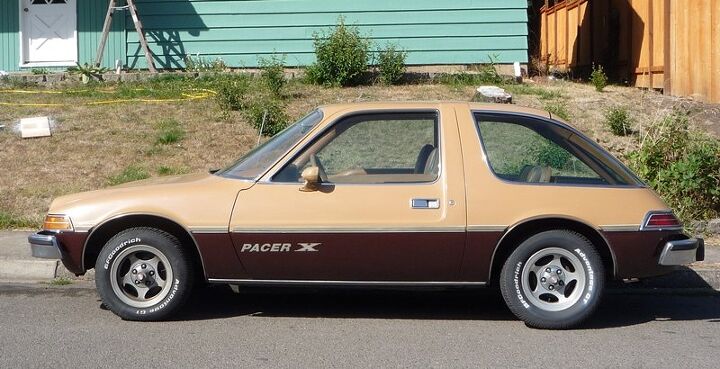Curbside Classic: 1975 AMC Pacer X

The Pacer is the poster child of how questionable ideas and good intentions go awry. In 1971, scrappy little AMC was faced with a dilemma: how to capture buyers looking to downsize, when they were incapable of actually building a truly downsized car. Yup; there was no way AMC could tool up to build a genuine compact car, like the Vega and Pinto. So the solution was to stop pretending, like the execrable Gremlin that preceded the Pacer. The answer was to build the world’s first wide-body compact, a segment nobody had ever identified before, much less pined for. To add to its zestiness, break all the styling molds with acres of glass and asymmetrical doors. And then just for good measure, stick a rotary engine in it. As we’ve seen repeatedly, desperation is the mother of (bizarre) inventions.
AMC explained the Pacer this way: it was “the first car designed from the inside out”. How about the first compact designed for the obese? The rationale was that a segment of Americans just weren’t going to be happy giving up their accustomed hip, elbow and love handle room for a cramped import or a Pinto. So it really started that way: cut everything away from AMC’s extravagantly-long Matador mid-size coupe except the seats and then design the shortest body possible around them. I’ve long had the desire to cut away about six feet on both ends of a ’71 Cadillac coupe. Dick Teague, my hero, had the same impulse and actually did it (not with the Caddy). Too bad Cadillac didn’t do the same thing for the Cimarron; now that would have been something memorable.
Then AMC signed a licensing contract with Curtiss-Wright for the rights to design and build a rotary engine to stick under the resulting stubby hood. When the idea of actually developing and tooling up for a Wankel started looking onerous (you think?), a deal with GM to buy their rotaries was cut. God, I love AMC. Too bad GM chickened out on that brilliant plan at the last minute. If they had actually built it, it would have undoubtedly made the Vega engine look like a paragon of durability. Good move on that one, GM.
But GM’s rude cancellation of their rotary program created a nasty little-big problem for AMC; the Pacer was designed just for that compact little five-gallon bucket sized engine, and there was nothing to take its place except the big AMC family of venerable cast-iron inline sixes. Nothing else to do but roll up the sleeves and get out the acetylene torches and start cutting away; that six had to fit somehow. Probably just as well in the end, even if the “compact” Pacer ended up weighing “an astounding 3425 lbs” (C/D) when it actually hit the road with a few options. An obese compact for obese compact-haters. Back then, that kind of weight was deep in mid-sized territory.
Teamed up with a choice of two de-smogged sixes (3.8 or 4.2 liter) that both made 100hp (ah, the good old days), performance was predictably leisurely. Later, a two barrel six and even the 304 V8 gave a boost, but by then the Pacer was already dead meat anyway. The Pacer was a wild gamble in hoping that a market niche existed for a highly truncated mid-sized coupe without a proper trunk: turns out it didn’t. Its Jetson-styling novelty gave it decent first-year sales of 145k units, then sales quickly withered away. Lousy gas mileage hastened the Pacer’s demise. American’s love for the latest toy is usually cut short either by ADD or the toy’s all-too obvious shortcomings. Or both.
Predictably, the American car magazines gushed over the Pacer, especially Motor Trend: “Suddenly its 1980: American Motors’ new Pacer is the freshest, most creative, most people oriented auto born in the U.S. in 15 years” Well, by 1980, folks had long moved on to genuinely modern small FWD cars (think Honda Accord) that could actually be comfortable, have real trunk space, be zippy, and didn’t get 15 mpg. The fact that the Accord arrived the same year that Pacer sales shriveled is perhaps no mere coincidence.
Small Cars had this to say on the Pacer’s styling: “admiration was an obvious reaction…the knowledgeable product writers knew without being told that they were privileged to be there to see something new in automobile design.” Privileged “knowledgeable product writers” indeed.
Car and Driver’s Don Sherman was distinctly more prescient in his assessment: “our first real urban transporter…There is, of course, the chance of monumental failure; it might be another Tucker ahead of its time or a pariah like the Marlin. But…with its high priority on comfortable and efficient travel and absence of Mach 2 styling, [it] at least seems right for the current state of duress. Consider this bold offering from AMC a test: Are we buying cars for transportation yet, or are they still social props?” Did you really have to ask, Don?
Road and Track offered this more objective take: “bold, clean and unique…even when it’s going 60 mph is looks as if it’s standing still..[Did they get that backwards, or were they saying something of significance with that?].” but noted that, even with the test car’s optional front disc brakes, “in the usual panic-stop tests…our driver had one of his most anxious moments ever as the Pacer screeched, skidded and demanded expert attention at the steering wheel to keep from going altogether out of control. The histrionics are reflected in long stopping distances from highway speeds… [The car’s] engineering—old-fashioned and unimaginative in the extreme—does not match the perky design”, which the magazine declared “most attractive to look at and pleasant to sit in.” Especially when its not moving.
The British The Motor just said: “We test the Pacer – and wish we hadn’t.”
Am I being harsh with the poor misunderstood Pacer? Oh well, it all seemed like a good idea in 1971, when AMC stylist Dick Teague started on his latest project after the almost equally adventurous and unsuccesful Matador coupe, which followed the not-so bold and daring Gremlin. Don’t get me wrong; I love Teague, and his playful and risk-taking approach. He did things no one else was doing, and he handled the dreadful 5 mph bumpers masterfully. Its just that he set himself to such difficult and improbable tasks, with solved them with such curious solutions. But he’s certainly enriched our automotive stylistic history.
The Pacer arrived with a number of shortcomings. The pathetically tiny luggage compartment was a particular sore spot, and AMC made the remarkably heroic effort to address that with an extended Pacer, a so-called wagon. Realistically, it was more like what should have been built in the first place, but in any case, it was too late to save the Pacer’s rapid crash. As was the slip of the surgeon’s scalpel that created the first automotive upper-lip lift.
Fitting its futuristic garb, and outfit called Electric Vehicle Associates converted Pacers to EVs, using eighteen six-volt golf-cart batteries for a claimed 53 mile range. Now that would be quite a find. Well, finding this pretty solid Pacer X wasn’t a bad find either; it’s been a while since there’s been one on the streets here. And this one was looking for a new home too; only $1500. What a bargain for a genuine mid-seventies period piece, an authentic Dick Teague original. Party on, Wayne!

More by Paul Niedermeyer
Latest Car Reviews
Read moreLatest Product Reviews
Read moreRecent Comments
- Jeff JMII--If I did not get my Maverick my next choice was a Santa Cruz. They are different but then they are both compact pickups the only real compact pickups on the market. I am glad to hear that the Santa Cruz will have knobs and buttons on it for 2025 it would be good if they offered a hybrid as well. When I looked at both trucks it was less about brand loyalty and more about price, size, and features. I have owned 2 gm made trucks in the past and liked both but gm does not make a true compact truck and neither does Ram, Toyota, or Nissan. The Maverick was the only Ford product that I wanted. If I wanted a larger truck I would have kept either my 99 S-10 extended cab with a 2.2 I-4 5 speed or my 08 Isuzu I-370 4 x 4 with the 3.7 I-5, tow package, heated leather seats, and other niceties and it road like a luxury vehicle. I believe the demand is there for other manufacturers to make compact pickups. The proposed hybrid Toyota Stout would be a great truck. Subaru has experience making small trucks and they could make a very competitive compact truck and Subaru has a great all wheel drive system. Chevy has a great compact pickup offered in South America called the Montana which gm could be made in North America and offered in the US and Canada. Ram has a great little compact truck offered in South America as well.
- Groza George I don’t care about GM’s anything. They have not had anything of interest or of reasonable quality in a generation and now solely stay on business to provide UAW retirement while they slowly move production to Mexico.
- Arthur Dailey We have a lease coming due in October and no intention of buying the vehicle when the lease is up.Trying to decide on a replacement vehicle our preferences are the Maverick, Subaru Forester and Mazda CX-5 or CX-30.Unfortunately both the Maverick and Subaru are thin on the ground. Would prefer a Maverick with the hybrid, but the wife has 2 'must haves' those being heated seats and blind spot monitoring. That requires a factory order on the Maverick bringing Canadian price in the mid $40k range, and a delivery time of TBD. For the Subaru it looks like we would have to go up 2 trim levels to get those and that also puts it into the mid $40k range.Therefore are contemplating take another 2 or 3 year lease. Hoping that vehicle supply and prices stabilize and purchasing a hybrid or electric when that lease expires. By then we will both be retired, so that vehicle could be a 'forever car'. And an increased 'carbon tax' just kicked in this week in most of Canada. Prices are currently $1.72 per litre. Which according to my rough calculations is approximately $5.00 per gallon in US currency.Any recommendations would be welcomed.
- Eric Wait! They're moving? Mexico??!!
- GrumpyOldMan All modern road vehicles have tachometers in RPM X 1000. I've often wondered if that is a nanny-state regulation to prevent drivers from confusing it with the speedometer. If so, the Ford retro gauges would appear to be illegal.












































Comments
Join the conversation
So awesome. I had a '75 Pacer, and it was the most comfortable, easy-to-drive car I've ever had. I'd grab another one in a second given the opportunity.
In the late '70's (and pre-airbag, pre-automatic seatbelt days except for a few like VW), the AMC Pacer was one of the safest cars on the road. Check some of the insurance company ratings from back then and you'll find the injury index for Pacer's involved in accidents was impressive.